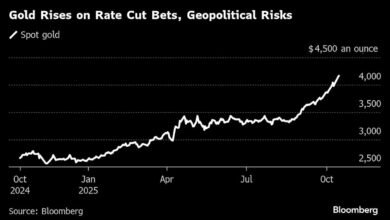Gold remains a safe haven asset, but no longer a reliable signal for equity trades, says ICICI Securities

A sharp rise in gold prices has historically been seen as a signal of weak stock market sentiment. However, brokerage firm ICICI Securities believes that, at this juncture, viewing gold prices as an indicator of equity-market risk may be misplaced.
“Excluding the post ‘Nixon shock’ period of the 1970s and 80s, gold has largely had an inverse correlation with stocks; thereby, establishing it as an excellent risk signal for equities. We believe, post 2022, we have entered a phase where gold prices, as a signal for risk in equities, may be unreliable till the ongoing reset in gold prices is complete,” said ICICI Securities.
“Since 2022, gold and equities’ inverse correlation seems to have faded, like it did in the 1980s, with both hitting all-time highs simultaneously. We believe this phenomenon is yet again driven by the new reset in gold prices, fuelled by an increased demand for the shiny metal by central banks as a reserve asset,” said the brokerage firm.
The brokerage firm highlighted the “reset period” of the 1970s for gold prices, when they were allowed to float freely, which triggered a sharp surge in gold prices.
“Post the ‘Nixon shock’ of 1971 – effectively ended the Bretton-Woods system – gold prices were unleashed from their suppressed level, having been fixed at $35/oz since 1934. This resulted in gold prices soaring for the next two decades, augmented by high inflation and geopolitical risks,” the brokerage firm observed.
“During this reset period for gold prices, the correlation between gold and equities broke down – displaying random negative and positive correlations, which, we believe, was just coincidental to the sustained rise in gold prices and not driven by causality,” said the brokerage firm.
On August 15, 1971, then US President Richard Nixon announced that the US would no longer convert US dollars to gold at a fixed value. This action is known as the ‘Nixon Shock.
This ensured gold could trade freely in the international market and brought an end to the Bretton Woods system, which had pegged other major currencies to the US dollar, which was, in turn, convertible to gold at a fixed price of $35 per ounce.
Gold’s signal for equities turning unreliable
Gold prices have jumped 40 per cent this year and are expected to extend their gain due to tariff-related risks, global uncertainties, aggressive central bank buying, and easing monetary policy.
ICICI Securities believes that gold’s inherent nature as a safe-haven asset class is intact. However, the brokerage firm stresses that there are phases when the structural resetting of gold prices makes it immune to risk.
For example, improving global growth prospects may increase investors’ risk appetite, which can trigger a rise in equities. However, gold, too, may continue rising due to central bank buying.
“If we assume that the global growth environment ameliorates ahead, with falling interest rates, it will likely usher in a risk-on environment for equities. However, gold prices should still continue to rise in said environment, given the central banks’ continued gold buying spree. Hence, such a trend may further strengthen a false, or coincidental, positive correlation seen since 2022 between stocks and gold, but would not explain causality,” said the brokerage firm.
After the global financial crisis (GFC), in 2010, the gold-equity negative correlation saw a breakdown. In this phase, ICICI Securities said, stocks rebounded from the rout they suffered during the 2008–09 period with the help of quantitative easing by central banks, even as gold continued to rise, providing a positive correlation.
Read all market-related news here
Read more stories by Nishant Kumar
Disclaimer: This story is for educational purposes only. The views and recommendations expressed are those of individual analysts or broking firms, not Mint. We advise investors to consult with certified experts before making any investment decisions, as market conditions can change rapidly and circumstances may vary.
Credit: Source link




